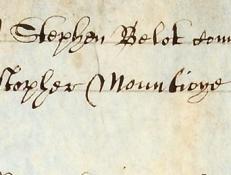Images reproduced by permission of The National Archives, London, England.
Terms of use
The National Archives give no warranty as to the accuracy, completeness or fitness for the purpose of the information provided.
Images may be used only for purposes of research, private study or education. Applications for any other use should be made to The National Archives Image Library, Kew, Richmond, Surrey TW9 4DU, Tel: 020 8392 5225 Fax: 020 8392 5266.
Document-specific information
Creator: Court of Requests
Date: 1612
Repository: The National Archives, Kew. UK
Call number and opening: REQ 1/199
Alan H. Nelson and Folger Shakespeare Library staff, "Bellott v. Mountjoy: Witness Book listing Shakespeare and others to be examined on Bellott's behalf in Easter Term," Shakespeare Documented, https://doi.org/10.37078/424.
The National Archives, REQ 1/199, ex parte Belott Easter term. See Shakespeare Documented, https://doi.org/10.37078/424.
Shown here is the Witness Book, from Easter term 1612, for the first round of depositions in Bellott v. Mountjoy. The lawsuit, begun on January 28, 1612, was between Stephen Bellott and Christopher Mountjoy, head of a French Huguenot family living in Silver Street in Cripplegate Ward, just north of Cheapside and St. Paul’s Cathedral. Members of the household included Christopher and Marie Mountjoy, their only child Mary, and Stephen Bellott, an apprentice in the family business, the fabrication of elaborate and fashionable headpieces called “tires.” The lawsuit concerns negotiations which led to the marriage of Stephen and Mary on November 19, 1604. Bellott complains that his father-in-law subsequently reneged on an agreement to support the young couple financially. On May 11, 1612, William Shakespeare deposed as a witness. Depositions in the case reveal that Shakespeare, then a lodger in the Mountjoy household, had been engaged to persuade Bellott to enter the marriage.
The Court of Requests initiated three rounds of depositions in Bellott v. Mountjoy. In each round, Stephen Bellott is identified as the complainant, and Christopher Mountjoy as the defendant. Here, for the first round, on behalf of the complainant, the witnesses are identified as Daniel Nicholas, Joan Johnson wife of Thomas Johnson, and William Shakespeare, gentleman. The depositions for the first round were given on May 11, 1612.
Twenty-six documents survive from Bellott v. Mountjoy. This is one of twelve documents that refers to Shakespeare explicitly or implicitly (including one with his signature). The lawsuit is generally unremarkable and Shakespeare’s involvement is minor. However, the case does contribute to our understanding of Shakespeare's life: that in 1604 he was living in Silver Street with a family of French Huguenot tiremakers. In 1909 Charles William Wallace and his wife Hulda Berggren Wallace discovered Bellott v. Mountjoy in the Public Records Office, now The National Archives.
[This transcription is pending final vetting. Transcriptions of Bellott. v. Mountjoy are based on Charles William Wallace, "Shakespeare and his London Associates, As Revealed in Recently Discovered Documents," University of Nebraska Studies, 10 no. 4 (1910), 260-360. This publication has a secondary pagination, followed here for individual entries: p. 17.]]
...
Stephen Belott plaintiff
XpoferMountioy defendant
[List of deponents:]
Danyell Nicholas
Johan Johnson vxor Thome Johnson
William Shakespeare gent
...
To learn more, read Alan H. Nelson's essay on lawsuits in Shakespeare's England.
Co-written by Folger Shakespeare Library staff and Alan H. Nelson
Sources
Charles William Wallace, "Shakespeare and his London Associates, as Revealed in Recently Discovered Documents" University of Nebraska Studies 10, no. 4 (1910): 17.
A full list of sources for Bellott v. Mountjoy is given under Bellott v. Mountjoy: First set of depositions.
Last updated February 1, 2020












![REQ 4/1/4/2 [1], thumbnail detail](https://shaxdoc.titania.folger.edu/sites/default/files/styles/document_thumbnail/public/document-thumbnails/REQ4-1-4-2%20%281%29%20The%20Belott%20v%20Mountjoy%20suit%2C%20deposition%20of%20Daniel%20Nicholas%201612_thumbnail%20detail.jpg?itok=qLDPDvNb)

![REQ 4/1/4/3 [1], thumbnail detail](https://shaxdoc.titania.folger.edu/sites/default/files/styles/document_thumbnail/public/document-thumbnails/REQ4-1-4-3%20%281%29%20The%20Belott%20v%20Mountjoy%20suit%2C%20deposition%20of%20Christopher%20Weaver%201612_thumbnail%20detail.jpg?itok=CccGcAQB)









